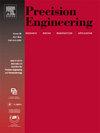利用高生产率参数揭示LPBF制备的Inconel 718表面粗糙度:双方法探索
IF 3.7
2区 工程技术
Q2 ENGINEERING, MANUFACTURING
Precision Engineering-Journal of the International Societies for Precision Engineering and Nanotechnology
Pub Date : 2025-04-14
DOI:10.1016/j.precisioneng.2025.04.012
引用次数: 0
摘要
增材制造的最新进展及其对金属材料的扩展导致了具有复杂几何形状和机械性能可与传统工艺相媲美的高科技部件的生产。尽管如此,增材制造的广泛采用仍然受到低生产率的限制。此外,由于工艺参数和表面粗糙度之间的复杂关系,优化工艺参数以提高生产率,同时保持高表面质量是具有挑战性的。本研究旨在通过激光粉末床熔合生产的Inconel 718样品,确定工艺参数与表面粗糙度之间的关系。棱镜标本印刷使用七个组合的工艺参数,逐步提高生产率。两种方法,传统的轮廓法和光学方法,进行了比较,以评估不同工艺条件下的表面质量。结果表明,工艺生产率与表面粗糙度之间存在很强的相关性,较高的生产率导致表面粗糙度增加高达200%。光学方法在检测尖锐的峰和谷方面表现出优越的灵敏度,提供比传统轮廓术更高的细节水平。此外,光学方法应用于传统技术不足的实际案例,为推进LPBF在各个工业领域的应用提供了重要见解。本文章由计算机程序翻译,如有差异,请以英文原文为准。
Unveiling surface roughness in Inconel 718 fabricated by LPBF using high-productivity parameters: A dual method exploration
Recent advancements in additive manufacturing and its extension to metallic materials have led to the production of highly technological components with complex geometries and mechanical properties comparable to traditional processes. Despite this, the widespread adoption of additive manufacturing remains limited by low productivity. Additionally, optimizing process parameters to enhance productivity while maintaining high surface quality is challenging due to the intricate relationships between process parameters and surface roughness. This study aims to identify the relationship between process parameters and surface roughness using Inconel 718 specimens produced via laser powder bed fusion. Prismatic specimens were printed using seven combinations of process parameters with progressively increasing productivity. Two methods, traditional profilometry and an optical approach, were compared to assess surface quality under varying process conditions. Results show a strong correlation between process productivity and surface roughness, with higher productivity leading to surface roughness increases up to 200 %. The optical method demonstrated superior sensitivity in detecting sharp peaks and valleys, providing higher detail levels than traditional profilometry. Additionally, the optical method was applied to a practical case where traditional techniques fall short, offering crucial insights for advancing LPBF applications in various industrial sectors.
求助全文
通过发布文献求助,成功后即可免费获取论文全文。
去求助
来源期刊
CiteScore
7.40
自引率
5.60%
发文量
177
审稿时长
46 days
期刊介绍:
Precision Engineering - Journal of the International Societies for Precision Engineering and Nanotechnology is devoted to the multidisciplinary study and practice of high accuracy engineering, metrology, and manufacturing. The journal takes an integrated approach to all subjects related to research, design, manufacture, performance validation, and application of high precision machines, instruments, and components, including fundamental and applied research and development in manufacturing processes, fabrication technology, and advanced measurement science. The scope includes precision-engineered systems and supporting metrology over the full range of length scales, from atom-based nanotechnology and advanced lithographic technology to large-scale systems, including optical and radio telescopes and macrometrology.

 求助内容:
求助内容: 应助结果提醒方式:
应助结果提醒方式:


